| Botanical Name |
|
| Family |
Asteraceae - The daisy family. |
| Pronunciation |
|
| Common Name(s) |
English: Hottentot's Bedding
Afrikaans: Kooigoed; Hottentotskooigoed
|
| Plant Group |
- Ground Cover A plant with a low-growing, spreading habit, grown specifically to cover the ground.
- Perennial A plant whose life cycle lasts for three or more seasons.
|
| Plant Size |
- Medium to Large
| Tree | 15m to 20m |
| Shrub | 2m to 3m |
| Perennial/ground cover | 60cm to 75cm |
| Bulb | 60cm to 1m |
| Succulent | 60cm to 1m |
|
| Position |
- Partial Shade The area is in shade for part of the day and in full sun for part of the day.
- Sun The area is in full sun for all or most of the day, all year round.
|
| General Information |
- Drought Tolerance: High The plant is well adapted to arid conditions; it can survive long periods of drought and high temperatures without extra water.
- Evergreen Plants that have leaves all year round.
- Fragrant / Aromatic These plants posses a strong, usually pleasant odour.
- Frost: Hardy The plant can withstand freezing temperatures or frost without artificial protection.
- Salt spray tolerant A plant with specific adaptations enabling it to grow in a saline environment.
- Sand tolerant Plants adapted to survive in nutrient poor, very sandy soils.
- Water Wise Plant species originating from low rainfall regions that require less water to survive and thrive than other plant species.
- Wind Tolerant Plants able to withstand the effect of strong winds.
|
| Specific Information |
Helichrysum crispum is a low-growing perennial with grey-green leaves and stems covered with white wooly hairs. Although variable in shape and size, the leaves are distinctively crisp and wavy. The plant does best in full sun and copes well with very dry conditions, sea breezes and wind. In more shaded positions the foliage is greener, stems may become lax and flowering may be compromised. The foliage has a pleasant aromatic smell but I found the flowers had a rather strange and not very pleasant odour, reminiscent of curry perhaps.
Both Helichrysum crispum and Helichrysum petiolare are known as 'kooigoed', an Afrikaans name meaning 'bedding stuff'. The Khoi people of the Cape used these aromatic plants as bedding, especially useful as they discourage insects as well.
|
| Ad Break |
|
| Flowers |
| Description |
tiny yellow flowers, without petals, clustered in small, dense rounded heads at the end of stems
|
| Season |
- Spring to Summer Plants will seldom bloom for the entire season as given in the list, but should flower during a period within these parameters.
|
| Colour |
|
| Growth Rate |
- Fast Specifying growth rate can be very misleading as there is considerable variation of growth rate depending on type and species of plant, available water, supplementary feeding, mulching and general care, as well as the plants suitability and adaptability to the garden environment.
|
| Plant Uses |
- Attracts bees, butterflies or other insects This plant attracts insects which can be food for birds or other creatures in your garden.
- Border A strip of ground, at the edge of a driveway or path in which ornamental plants or shrubs are planted.
- Container Trees, shrubs and ornamental species that can adapt to growing in a restricted environment.
- Filler Either a fast growing tree or shrub used temporarily to fill in an area while the permanent plants grow to a desired size, or a plant used to fill gaps in borders or beds.
- Foliage Plant Plants grown because their foliage is colorful or unique. Many of these plants have insignificant flowers.
- Ground Cover Low-lying plants that spread fast, require minimal maintenance, and cover large expanses or bare areas between bulbs or shrubs. They provide protection from erosion and drought and improve the visual appearance of the garden.
- Pioneer for new gardens A very fast growing plant, able to withstand hardship, that can be used to populate land that has recently been cleared of natural vegetation. These plants pave the way for slower-growing species by adding nutrients to the soil and creating leaf litter.
- Rock Garden An area constructed of larger rocks, arranged naturally, to emphasise the use of stones as a main element. Generally plants used do not need a lot of care.
- Stabilize Banks Plant is used to prevent soil erosion because their roots will form a mat that stabilizes the soil and keeps it from washing away in heavy rains.
- Suitable for coastal gardens Plants adapted to dry, sandy soil, forceful wind, limited rainfall and intense sunlight.
- Suitable for seaside gardens Plants that will survive the hostile environment of harsh salty winds, dry sandy soil, irregular rainfall and heat found in seaside gardens.
- Wild Garden An indigenous garden planted for the benefit of wildlife and birds. Provides food, water, a variety of mini-biomes and no poisonous chemicals are used.
|
| Distribution and Habitat |
in the Western Cape, along the coast from Bloubergstrand to George, among fynbos, on coastal and inland dunes and other sandy places
|
| Planting Suggestions |
Plant in a sunny or semi-shaded, well drained position. This plant will rot if it stands in poorly drained soil. The occasional addition of compost or fertilizer will encourage vigorous growth but is not a necessity. Light, regular pruning will keep the plant neat and rounded. Water until established then only when very dry. This water wise plant will thrive with the minimum of attention. In areas where conditions are particularly to its liking, the plant is said grow quite vigourously, clambering over other plants and almost becoming a weed, but in my garden I have found it to be quite well behaved.
|
| Lorraine's Garden Notes |
I have been delighted with this plant and intend to use it a lot more. I have only had it for a year, so I do not know how long it will last or whether it will need replacing periodically. It roots along the ground below the plant so new plants are easy to propagate. I clipped it back very little at a time to keep it neat and dense.
|
| Medicinal Uses |
Helichrysums are widely used for many ailments and Helichrysum crispum is one of the most popular. The Khoi used it for a racing heart, coronary thrombosis and hypertension.
It is reportedly being used for high blood pressure, in the treatment of diabetes, arthritis and heart problems in animals.
Visit http://www.villagelife.co.za/Mathia_3.html for recipes and dosage.
|
| Ad Break |
|


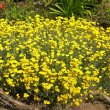
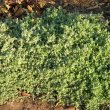
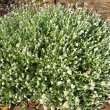
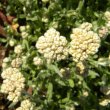
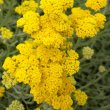
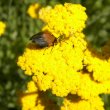
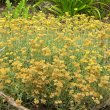
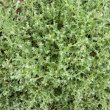



Discuss this plant
Share knowledge, ask a question or give an experience.